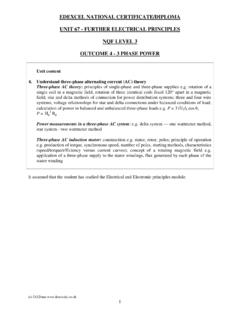Transcription of EDEXCEL NATIONAL CERTIFICATE UNIT 10: …
1 EDEXCEL NATIONAL CERTIFICATE . UNIT 10: PROPERTIES AND APPLICATIONS OF ENGINEERING. MATERIALS. NQF LEVEL 3. OUTCOME 1 - TUTORIAL 1. THE STRUCTURE and PROPERTIES OF METALS. Unit content 1 Be able to describe the structure of and classify engineering materials Atomic structure: element; atom nucleus, electron; compound; molecule; mixture; bonding mechanisms covalent, ionic, metallic Structure of metals: lattice structure; grain structure; crystals; crystal growth; alloying interstitial, substitutional; phase equilibrium diagrams eutectic, solid solution, combination.
2 Intermetallic compounds Structure of polymeric materials: monomer; polymer; polymer chains linear, branched, cross- linked; crystallinity; glass transition temperature Structure of ceramics: amorphous; crystalline; bonded Structure of composites: particulate;. fibrous; laminated Structure of smart materials: crystalline; amorphous; metallic Classification of metals: ferrous plain carbon steel, cast iron (grey, white, malleable, wrought iron), stainless and heat-resisting steels (austenitic, martensitic, ferritic); non-ferrous aluminium, copper, gold, lead, silver, titanium, zinc.
3 Non-ferrous alloys aluminium-copper heat treatable wrought and cast, non-heat-treatable wrought and cast, copper-zinc (brass), copper-tin (bronze), nickel-titanium alloy Classification of non-metals (synthetic): thermoplastic polymeric materials acrylic, polytetrafluoroethylene (PTFE), polythene, polyvinyl chloride (PVC), nylon, polystyrene;. thermosetting polymeric materials phenol-formaldehyde, melamine-formaldehyde, urea- formaldehyde; elastomers; ceramics glass, porcelain, cemented carbides; composites eg laminated, fibre reinforced (carbon fibre, glass reinforced plastic (GRP), concrete, particle reinforced, sintered; smart materials electro-rheostatic (ER) fluids, magneto-rheostatic (MR).)
4 Fluids, piezoelectric crystals Classification of non-metals (natural): wood, rubber, diamond 1. CONTENTS. 1. INTRODUCTION. 2. Introduction to Materials Classification and Terminology Crystalline Amorphous 3. Atomic Structures of Materials. Atomic Structure Types of Bonds Crystal Lattices Carbon 4. Structure of Metals Ferrous Non Ferrous 5. Heat Treatment Ferrous Non Ferrous 1. INTRODUCTION. In engineering and technology the knowledge of materials has been at the forefront of science and has enabled us to produce amazing advances in all fields from medicines to electronics.
5 We need to know about the mechanical properties (such as strength, durability, ductility and so on), the thermal properties (such as specific heat, melting point and conductivity), electrical properties (such as resistivity), magnetic properties, optical properties and many others. This module is about materials used for manufacturing, in particular metals, plastics and ceramics. The more you understand the molecular structure of atoms, the more you will understand the nature of the material that can be made from them.
6 The goal of this module is to enable you to select the best materials to manufacture a given item so that it performs the desired task and can be made as economically as possible. All materials are made up of atoms and combinations of atoms called molecules. The structure determines the engineering properties of the material . The following explanation about atomic structure is not comprehensive but beginners might think so. The subject is much more complex than described here and studying it will leave unanswered questions.
7 There is a wealth of information on the internet and much of it appears contradictory. This is because explanations are often simplified to avoid going into too much detail. Hopefully the information here is sufficient to give you a good start on understanding engineering materials. One of the most useful websites for finding materials is Most of the self assessment for this tutorial is in the form of separate assignments. 2. 2. INTRODUCTION TO material CLASSIFICATION AND TERMINOLOGY. Engineering materials are classified in various ways depending on the properties of the materials you wish to highlight.
8 The chart below shows the way they are classified in this tutorial and during the course of the tutorial you will learn what is special about them. 3. ATOMIC STRUCTURE OF MATERIALS. The way atoms join together to form a solid material can be in a strict pattern (crystalline) or just a uniform mixture (amorphous). CRYSTALLINE. Many materials crystallise when cooled slowly sugar and salt. As solidification occurs the molecules bond together in regular patterns to form individual crystals or grains that join with other similar crystals at the boundary.
9 When processed, the crystals may be aligned or elongated in one direction producing different properties in different directions. AMORPHOUS. This is a structure with no crystals and often results from rapid cooling. For example molten sugar poured onto a cold surface forms an amorphous glass like structure instead of crystallising. The structure is uniform with the molecules having random positions within it. The mechanical properties are usually the same in all directions. Liquids are amorphous and when a metal melts, a crystalline structure will change into an amorphous liquid.
10 Materials may exist in a pure form or in some other form in a combination with other materials. How atoms and molecules stick together largely depend on its atomic structure and you should study this next. ATOMS. All substances are made up from atoms. A substance made from only one type of atom is called an element. Often the atoms rearrange themselves into molecules containing two or more atoms either of the same substance or of more than one substance. There are 92 different elements occurring naturally. The smallest and simplest is the hydrogen atom and the largest is uranium.












